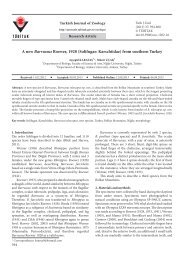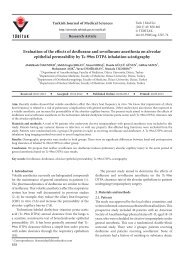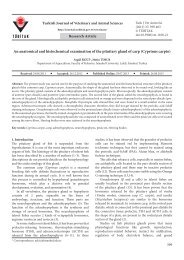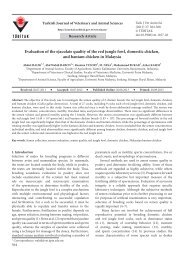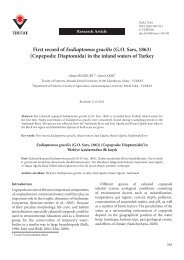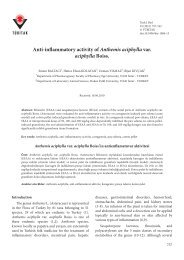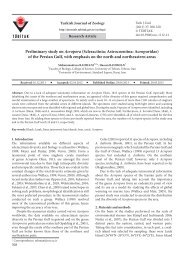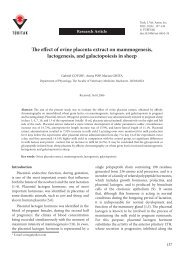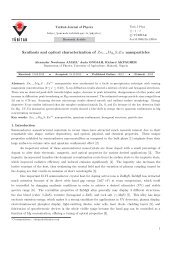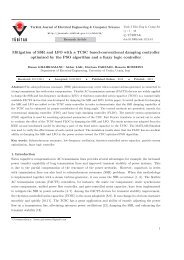Messinian forced regressions in the Adana Basin: a near ... - Tübitak
Messinian forced regressions in the Adana Basin: a near ... - Tübitak
Messinian forced regressions in the Adana Basin: a near ... - Tübitak
Create successful ePaper yourself
Turn your PDF publications into a flip-book with our unique Google optimized e-Paper software.
10<br />
°<br />
or multiple cross-strata sets, 25–60 cm thick, <strong>in</strong>dicate<br />
transverse or oblique midchannel bars (Miall 1985).<br />
This contrast<strong>in</strong>g facies assemblage <strong>in</strong> <strong>the</strong> Muratlı<br />
Member forms <strong>the</strong> <strong>in</strong>fill of an axial valley that was deeply<br />
<strong>in</strong>cised <strong>in</strong> <strong>the</strong> delta. The top part of <strong>the</strong> valley-fill and <strong>the</strong><br />
surround<strong>in</strong>g host delta are not preserved <strong>in</strong> <strong>the</strong> outcrop<br />
section, but <strong>the</strong> measured depth of <strong>in</strong>cision is at least<br />
15 m and <strong>the</strong> valley width is up to 60 m. The <strong>in</strong>cised<br />
valley is clearly not an <strong>in</strong>tegral part of <strong>the</strong> prograd<strong>in</strong>g<br />
delta’s topset (see discussion by Hampson et al. 1997) and<br />
<strong>in</strong>stead <strong>in</strong>dicates erosional cannibalisation of <strong>the</strong> delta by<br />
a deep <strong>in</strong>cision of its fluvial feeder system <strong>in</strong> response to<br />
pronounced base-level fall (see Mellere et al. 2002; Ilgar<br />
& Nemec 2005; Breda et al. 2009). The high depth/width<br />
ratio of <strong>the</strong> valley and <strong>the</strong> scattered boulders suggest<br />
relatively rapid <strong>in</strong>cision, with a m<strong>in</strong>imal lateral shift<strong>in</strong>g<br />
of <strong>the</strong> fluvial system (see Yoxall 1969; Wood et al. 1993)<br />
and with <strong>the</strong> stream competence significantly <strong>in</strong>creased by<br />
<strong>the</strong> topographic conf<strong>in</strong>ement (Schumm 1993). The valley<br />
<strong>in</strong>cision seems to have occurred concurrently with <strong>the</strong> late<br />
stages of <strong>the</strong> delta progradation, when <strong>the</strong> entrench<strong>in</strong>g<br />
fluvial system acted as a feeder for <strong>the</strong> youngest telescop<strong>in</strong>g<br />
parts of <strong>the</strong> delta (Figure 7a). The down-stepp<strong>in</strong>g pattern<br />
of delta topset (Figure 7b) strongly supports <strong>the</strong> notion of<br />
an <strong>in</strong>cremental fall of <strong>the</strong> delta shorel<strong>in</strong>e trajectory.<br />
The relatively narrow valley filled with fluvial deposits<br />
<strong>in</strong>dicates that <strong>the</strong> <strong>in</strong>fill<strong>in</strong>g of <strong>the</strong> valley was relatively rapid,<br />
under a high rate of sediment supply, with little lateral<br />
wander<strong>in</strong>g of <strong>the</strong> river and no significant valley-side<br />
collapses at <strong>the</strong> sea-level lowstand stage.<br />
ILGAR et al. / Turkish J Earth Sci<br />
Figure 5. An oblique transverse section through <strong>the</strong> Muratlı delta, <strong>Adana</strong> Bas<strong>in</strong>, show<strong>in</strong>g a gravel-filled axial fluvial valley deeply<br />
<strong>in</strong>cised <strong>in</strong> <strong>the</strong> delta deposits. Palaeotransport direction is away from <strong>the</strong> viewer, obliquely to <strong>the</strong> right. Picture from locality 2 <strong>in</strong><br />
Figure 1c.<br />
6. Sequence-stratigraphic <strong>in</strong>terpretation<br />
The late Tortonian shorel<strong>in</strong>e of <strong>the</strong> bas<strong>in</strong> is represented<br />
by <strong>the</strong> reefal limestones of <strong>the</strong> Tırtar Formation, which<br />
were superimposed directly on <strong>the</strong> earlier bas<strong>in</strong>-marg<strong>in</strong><br />
limestones of <strong>the</strong> Karaisalı Formation (Figure 2) and were<br />
later extensively eroded (Figure 1c). The 3 deltas <strong>in</strong> <strong>the</strong>ir<br />
location appear to have been offset bas<strong>in</strong>wards by ~25 km<br />
with respect to <strong>the</strong> late Tortonian shorel<strong>in</strong>e and emplaced<br />
directly onto <strong>the</strong> offshore mudstones of <strong>the</strong> Handere<br />
Formation, which <strong>in</strong>dicates a <strong>forced</strong>-regressive erosional<br />
shift of <strong>the</strong> shorel<strong>in</strong>e.<br />
A <strong>forced</strong> regression is <strong>in</strong>dicated by <strong>the</strong> downstepp<strong>in</strong>g<br />
geometry of <strong>the</strong> delta topset (Figure 7b), <strong>the</strong> cl<strong>in</strong>oformal<br />
foreset wedges that sharply downlapped <strong>the</strong> bas<strong>in</strong> floor<br />
(Figures 4a and 6), and fur<strong>the</strong>r by <strong>the</strong> <strong>in</strong>cision of fluvial<br />
valley along <strong>the</strong> delta axis (Figures 5 and 7a). The sharp,<br />
erosional basal surface of <strong>the</strong> delta marks an abrupt<br />
facies change and passes bas<strong>in</strong>wards <strong>in</strong>to a correlative<br />
depositional conformity (Figure 7a). The aggradational<br />
<strong>in</strong>fill<strong>in</strong>g of <strong>the</strong> <strong>in</strong>cised valley documents a subsequent rise<br />
of relative sea level, and <strong>the</strong> overly<strong>in</strong>g gypsiferous deposits<br />
<strong>in</strong>dicate a brief drown<strong>in</strong>g of <strong>the</strong> deltas. The evaporites<br />
occur as erosional relics of <strong>the</strong> latest mar<strong>in</strong>e deposits<br />
(HST) <strong>in</strong> <strong>the</strong> bas<strong>in</strong>, which implies yet ano<strong>the</strong>r subsequent<br />
<strong>forced</strong> regression (see <strong>the</strong> late <strong>Mess<strong>in</strong>ian</strong> erosional FRST<br />
<strong>in</strong> Figure 2).<br />
The Tortonian–<strong>Mess<strong>in</strong>ian</strong> deposits of <strong>the</strong> Kuzgun<br />
and Handere formations (Figure 2) have previously been<br />
<strong>in</strong>terpreted as a simple regressive succession (Yetiş 1988;<br />
Yetiş et al. 1995), which would imply a normal-regressive



